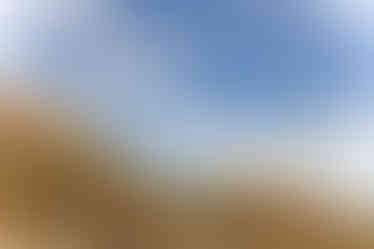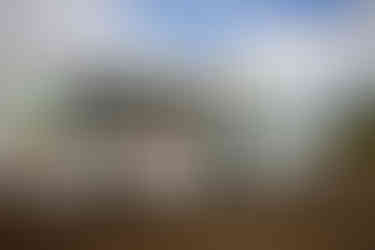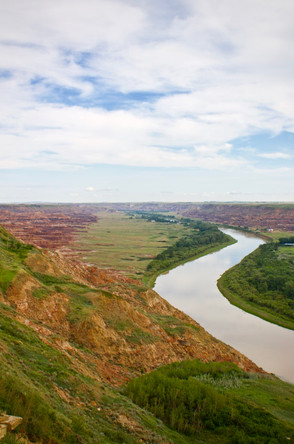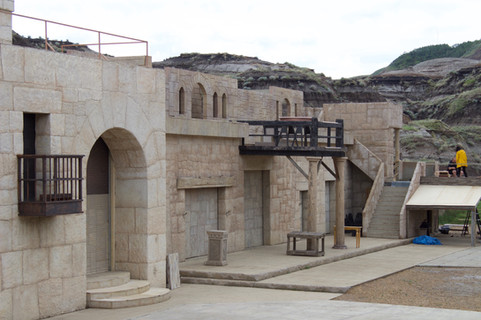Cruising Through Drumheller's Wild West Badlands
- Emily Fata
- Dec 11, 2018
- 12 min read
During her time in the province of Alberta this summer, Wanderous Affair's editor-in-chief, Emily Fata, took a day trip to the town of Drumheller with two of her cousins. Thanks to the award-winning Wild West Badlands Tours, they made the most of exploring this incredible landscape.

While staying with my cousins in Edmonton for nearly two months this summer, it was no surprise that we had a multitude of day trips planned together. I had spent three weeks in the city in 2017, so I wanted to see the off-the-beaten-path attractions beyond Edmonton's borders during my second trip; this was when the town of Drumheller and its surrounding area were suggested. Actually, I had first heard about this beautiful location from my best friend Marta, who visited the Fukui Dinosaur Museum while travelling through Japan in 2017 (the sister museum of Drumheller's Royal Tyrell Museum of Palaeontology). Having an interest in palaeontology myself, this naturally had piqued my interest.
We started our day trip by leaving home at 5.00am, heading out onto the empty roads with minimal daylight and a car filled with snacks and drinks. Reaching Drumheller was a gorgeous drive itself, with an opaque mist settling over the expansive prairies as we drove down the long country roads. At one point, I couldn't help but ask to stop the car, so that I could attempt to capture the moment. It turned out to be one of my favourite photos of all time (which, if you're interested, you can buy a postcard of in Wanderous Affair's shop by clicking here).

It was quite obvious when we were nearing our destination, with the flat rolling fields slowly morphing into the unmistakable coloured layers of stone and sediment forming the Canadian Badlands just outside our window. This area of Canada's west derived its name from the French settlers, who were among the earliest foreigners to explore the interior of western North America; unlike the Indigenous people who had been living here for hundreds or years prior, Europeans described this location as "mauvaises terres à traverser", meaning “bad lands to cross”. Thus, we now have our 'badlands'.
When we drove into town, it was obvious that they took their title as "Dinosaur Capital of the World" very seriously: not only were the streets lined with various genera (and colours!) of dinosaurs, but one particular reptile took the cake.
The world's biggest dinosaur loomed over Drumheller, a giant green landmark visible from far and wide (more on this later). It made sense of course, that it was under this easy-to-find spot that we were to meet our tour leaders, Don and Val Johnston, for our Wild West Badlands Tour.
Because it was still off-season when we went (the first week of June, on a weekday), we were lucky enough to have a "private" tour with just us three cousins, undistracted by other tourists in a typical group. When we boarded the Johnstons' air conditioned fourteen-seater bus, I knew right away that I would have a comfortable ride thanks to the high-backed passenger seats with aisle side arm-rests (and, of course, seat belts). The bus itself had padded cloth walls and a high ceiling, a blessing when you're as tall as I am and used to having to crouch and waddle to your seat in most situations like this. This roominess, in combination with the large windows, made for great views of the Alberta Badlands on our tour to come.
Once we settled into our seats, we began our tour through Alberta's breath-taking badlands...

The Little Church
Located on Murray Hill Road, the first stop on our tour was the Little Church. This tiny place of worship was originally constructed in 1968 by local contractor Trygve Seland before being reconstructed by local inmates from the Drumheller Institution in 1991. It seats a mere six people at a given time in its tiny 11" by 7" footprint, but is a beautiful spot to sit for a moment and reflect. I'm not terribly religious myself, but I do feel that I am spiritual, and found this peaceful structure posed a wonderful opportunity to pause and reflect.
That all being said, the Little Church is surrounded by colourful hills, each broken up into distinct layers of reds, oranges, browns, and greys that the 13,000-year-old badlands are known for. While admiring these colossal mounds of sandstone, mudstone, coal, and shale, our tour leaders began explaining the history of how these magnificent landforms came to be through a natural process over many thousands of years. It is also here that we learned that the vast majority of dinosaur fossils can be found in the highest light grey sandstone layer in a given badlands "mountain". Either by digging (which is unadvisable) or through natural erosion, fragments of dinosaur bone, petrified wood, and are other fossils become exposed.
Be forewarned however, that should you find a fossil yourself, it is illegal to remove them from the location in which they are discovered. You are allowed to take photographs of the fossils (or with the fossils, if you wish!), but cannot take them home with you.

Horse Thief Canyon
The second stop of our Wild West Badlands Tour was at Horse Thief Canyon, an awe-inspiring piece of nature that easily became my favourite place of the tour (it's located just off highway 838 at 13408 129 Avenue). This 17km-long canyon runs along the North Dinosaur Trail, with some of the most significant fossil discoveries having been made in the area; it's rich with over thirty-five species, dating back over seventy million years. As well, it has been featured in various Hollywood movies, including Shanghai Noon (2000), among others.
Once the bus was parked, tour leaders Don and Val explained to us how the grassy fields overlooking the canyon were inhabited by adorable little prairie dogs. These creatures were completely familiar with the couple, racing out of their underground burrows upon hearing the sound of the bus' engine for the treat they knew would follow. The Johnstons' procured a handful of crackers, which we broke into small pieces and held out to our new furry friends. These little guys approached us with caution, building up the courage to come and pluck the teeny bits of cracker right from our fingers before scurrying back into their holes to eat. Some of the braver ones in the lot ate directly in front of us, so long as we stayed still.
We then made our way closer to the canyon, side stepping various burrows in the ground and stopping on occasion to feed yet another prairie dog who was too cute to pass by. We only toured the canyon from above, being driven directly to an ideal vantage point where one could view the entirety of it without any visual obstructions. Beyond the rocky gorge, stunning fields of yellow canola could be spotted in the distance, adding yet another beautiful pop of colour to the already multi-coloured canyon spread out before us. My cousins and I took several pictures together here, but I found it difficult to spend too much time peering at the landscape through a camera lens when I was able to admire it first-hand through the naked eye.
For those wanting to immerse yourself in Horse Thief Canyon further, there's also the opportunity to hike it! Keep in mind that there are no interpretive signs in this area, making it easy to get lost if you're wandering around without paying attention to your whereabouts. Nonetheless, hiking Horse Thief Canyon would be an incredible adventure, one that rewards hikers with endless natural beauty and a solid workout.

Bleriot Ferry
Carrying us to the second leg of our journey was the Bleriot cable ferry located at AB-838 in Kneehill County. The ferry links the two sections of the North Dinosaur Trail where it crosses the Red Deer River, from Kneehill County on the west to Starland County on the east; it's also the quickest way of getting from Point A to Point B without having to drive well out of your way to cross the murky river.
The man who runs the ferry is super friendly and clearly knew the Johnstons' well, chatting away with us as we made our way across the river. All in all, the trip across was very quick in comparison to other ferry rides I've taken in the past, but it was still a steady (and fun!) one.

Red Deer River
Once we crossed via ferry, the next location on our tour was the other side of Red Deer River. From this vantage point, we could see across the water many of the spots we had been touring not long before. Here, we carefully made our way down the mountainside to get a close look at the valley below and to capture a few photos.
If you're not completely keen on balancing your way down narrow pathways to make your way closer to the river, there are several wooden benches along the face of the hill, positioned toward the expanse beyond. It's the perfect spot to sit for a while and admire the beauty surrounding you or, if you have the time, to stop and read a book. Can you think of a better place to unwind?
Before continuing to the next destination on our tour, we stood around the bus talking to our tour leaders, who told us some stories about themselves: from how they came to own Wild West Badlands tour company, to how they met each other. Curious to hear these stories yourself? Booking a tour with Don and Val is the answer to those burning questions!

The Canadian Badlands Passion Play Site
Performed annually each July since 1994, the Passion Play takes place in the natural bowl of Drumheller Valley's outdoor amphitheater, at 605 17th Street SW. The exact location was chosen because of its similarity to the Israeli countryside surrounding Jerusalem, in addition to its stellar natural acoustics.
As can be imagined, the play follows the story of the life, death, and resurrection of Jesus Christ (as told by the Gospels). The story is conveyed through both drama and music, utilizing an incredible 200+ volunteer performers. According to Wikipedia, "every five years or so, the script is rewritten to tell the story from a fresh perspective", which is great news for anyone wanting to come see the play more than just once. Over 10,000 people come annually from across Alberta, as well as from around the world; some of these individuals are pilgrims, while others are simply interested in having the opportunity to see such a massive theatre production.
Because we visited in early June, the play was not on. However, volunteers were still there improving the existing sets and we were able to walk around the perimeter of the venue to check out the scenery. Even without seeing the actual production, it's obvious the amount of time and energy invested into the show year-round to make it come to life each July.

Rosedale Suspension Bridge
Also known as the Star Mine Suspension Bridge, this structure was constructed in 1931 and originally built for the coal workers of Star Mine. With only encouragement for bravery, our tour leaders sent my cousins and I across the bridge to explore the other side ourselves.
A school group had just exited, leaving us to make our way across the 117 metre-long pedestrian bridge without the nuisance of other tourists. Though I am fearful of other things (*ahem* spiders), thankfully heights do not make the list. I happily paused along the way to drink in the uninterrupted view of the river and surrounding badlands, once again thankful for having an opportunity to be immersed in such a breath-taking environment.
Upon reaching the other side of the bridge, we walked around for about ten minutes, snapping a few pictures of the mountains and the distant mine shaft leading into what was once the Star Mine. Though we opted to turn back to return to the Johnstons' and their lovely bus, visitors have the opportunity to enjoy hiking and hill climbing in the area, should they desire!

Drumheller Hoodoos
Our second-last stop on the tour, the Hoodoo Trail was like something out of a sci-fi movie. Located in the East Coulee just off the AB-10, metal stairs guide you through these fantastical chimney-like formations, whose name derives “from the Hausa Language originating in West Africa, meaning 'to arouse resentment and to practice retribution'. Hoodoo was a distinct magic practice introduced to North America in the 18th Century. Aboriginal People used Hoodoo to refer to evil, supernatural forces" (as per a sign in the park).
We lingered for a while amongst the Hoodoos, soaking in their oddly shaped splendour and feeling a strange sense of peace amongst them. Because it was off-season, the area was pleasantly quiet and had very few tourists. We decided to leave when a large group of elementary-aged students came barrelling up stairs toward us. We moved on, to leave them to enjoy it on their own.
If I were to return to Drumheller, I would love to take a hike through the trail and climb the surrounding hills to view the Hoodoos from above. This would be something you would have to do separate from a regular tour, as they typically run on a schedule and don't leave much time for wandering around. Whatever you choose, I would advise on wearing close-toed, sensible shoes; I wore ballet flats and found they got very dirty during my tour. You know what they say, though... live and learn!
Do you love these views as much as I did? You can grab yourself a postcard of the Hoodoos Trail in Wanderous Affair's shop by clicking here

Last Chance Saloon and Rosedeer Hotel
Last but certainly not least, our final stop of the tour was in the town of Wayne at the Last Chance Saloon and attached Rosedeer Hotel, which opened in 1913. Not only is this kitschy place a collector's paradise (albeit, nothing in there is for sale), it's also a must-see for those who are intrigued by paranormal activity.
As told by Don and Val, the third and uppermost floor of the hotel is closed for this very reason. When two miners — George and John — were fighting to form a union to support themselves and their fellow workers, mine owners sent a group of thugs to teach them a lesson. Both men had rooms on the third floor of the Rosedeer Hotel (where they worked out of) and were murdered there. Legend has it that these two men are the main spirits to inhabit the place, and sometimes make their way down to the saloon itself to knock things off the counter or turn off the lights.
However, a 2011 article by Mark Stachiew in the Vancouver Sun, titled “Ghost Hunting in the Badlands”, tells a slightly different tale. In his story, punks from the local Ku Klux Klan were hired by the mine to get chummy with the clientele in the hotel's saloon while secretly on the lookout for Communists. Similar to the Johnstons' story, this was anyone who sought to organize a miners' union. The article says that "[o]n occasion, they would take undesirables up to one of the hotel rooms and give them a good beating, burn them with cigarette butts or tar and feather them — whatever it took to deliver the message that they weren't welcome in Wayne. At least one time, it's said, the roughs went too far with their victim. Something bad happened on the third floor, which remains closed to this day.”
Naturally, as we all sipped our drinks (my cousins' and I drank cocktails while Val and Don drank coffee and shared a slice of delicious-looking apple pie), and in between enjoying the music pouring from the saloon's rare vintage band box, I kept my eyes peeled for anything out of the ordinary. Though you can stay the night in any of their six hotel rooms, each with its own unique theme, I don't think I would ever be able to work up the courage to venture that.
In order to make your way to the saloon, you must drive across the Eleven Bridges of Wayne, running along a 6km stretch between Rosedale and Wayne. The single-lane metal bridges now carry traffic both over Rosebud River and the now-defunct railway tracks that were once used to transport coal both to and from local mining communities. In fact, these bridges made the Guinness Book of World Records for containing the most bridges found within the shortest distance!
As we pulled out of the saloon's parking lot and made our way back over the eleven bridges toward Drumheller's downtown, Val and Don put on a catchy little country song for us, which had us laughing at the hilarious truth of it all (hey, us Canadians are great!):

World's Largest Dinosaur
We ended off the tour at the same place where it began. After thanking Don and Val for an incredible time in Drumheller, we parted ways and made our way into the gift shop beneath the world's largest dinosaur; standing at 86 feet (25 metres), this 65 tonne female Tyrannosaurus Rex cost a whopping $1,065,000 to build. We each paid the $4 entrance fee to the gift shop's cashier before making our way through the adjacent doors to begin the steady climb up the 106 stairs running through her lengthy body. After our little hike, we finally reached the lookout point nestled in her lower jaw.
From this vantage point, you could see the stunning landscape of Drumheller and beyond. In fact, my cousins and I began pointing out the visible locations that we had just recently visited during our time with Wild West Badlands Tours. Though the uphill climb (admittedly) left this out-of-shape girl panting by the time she reached the top, it was 100% worth it for the view.
Truly, I could not have had a more amazing time exploring the Canadian badlands. Don and Val Johnston of Wild West Badlands Tours were incredible tour guides, and gave us the best experience we could have possibly had. Going above and beyond the average tour, I not only was able to learn so much about the area we were exploring, but had many laughs along the way.
I would highly recommend a visit to the town of Drumheller to anyone touring the province of Alberta, especially those who are a sucker for a stunning landscape. Taking the same tour that we did during your stay is the optimal way to make the most of your time here.
Bon voyage!
X,
Emily













































Comments